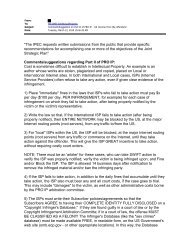We Energies Coal Combustion Products ... - The White House
We Energies Coal Combustion Products ... - The White House
We Energies Coal Combustion Products ... - The White House
You also want an ePaper? Increase the reach of your titles
YUMPU automatically turns print PDFs into web optimized ePapers that Google loves.
Geological Survey maintains a large database of uranium and thorium data<br />
on coal from various US coal fields. Based on more than 5000 coal samples<br />
from all the major coal regions in the US, the average U content of 1.3 parts<br />
per million (ppm) equals 0.44 pCi/g. <strong>The</strong> average thorium (3.32 ppm)<br />
concentration is 0.37 pCi/g. <strong>The</strong>se concentrations are not that much different<br />
from soil: 1.0 pCi/g for uranium (range 0.12 – 3.8 pCi/g) and 0.98 pCi/g for<br />
thorium (range 0.1 – 3.4 pCi/g). Both uranium and thorium decay to stable Pb<br />
and along the way produce radioactive isotopes of uranium, thorium, radium,<br />
radon, bismuth, lead, and polonium. Ra-226 analyses of coal indicate<br />
concentrations in the range of 0.2 – 3 pCi/g [J. Tadmore, J. of Environmental<br />
Radioactivity 4(1986) 177-204]. Lignite, a low-grade coal, has slightly higher<br />
concentrations: U-238, 8.26 pCi/g; Ra-226, 9.34 pCi/g; Th-232, 0.51 pCi/g;<br />
K-40, 4.67 pCi/g [Rouni et. al., Sci. Total Environment 272(2001) 261-272]. In<br />
coal-fired power plants, some of the NORM is released via the stack whereas<br />
most is trapped in the resulting ash. Studies in Great Britain (K. R. Smith et.<br />
al., Radiological Impact of the UK Population of Industries Which Use or<br />
Produce Materials Containing Enhanced Levels of Naturally Occurring<br />
Radionuclides, Part I: <strong>Coal</strong>-fired Electricity Generation, National Radiation<br />
Protection Board report, NRPB-R327, 2001) and the United States (EPA,<br />
Study of Hazardous Air Pollutant Emissions from Electric Utility Steam<br />
Generating Units – Final Report to Congress, EPA-453/R-98-004a, Feb.<br />
1998) conclude that NORM emissions from coal-fired plants do not pose a<br />
health problem. A United Nations group of experts reached a similar<br />
conclusion (UNSCEAR, 1993).<br />
T. <strong>The</strong> NORM concentration in coal ash is higher than in the coal because most<br />
of the radionuclides stay in the ash as compared to being released to the air<br />
during the combustion process. <strong>The</strong>refore, burning off the organic content of<br />
the coal results in about a 10-fold increase in U, Th, and Ra concentrations in<br />
the ash as compared to the coal (UNSCEAR, 1993; USGS Fact Sheet FS-<br />
163-97). Based on the concentration process, the Ra-226 concentrations in<br />
ash could be on the order of 1-30 pCi/g. Analyses of various ashes and ash<br />
products produced at WE-<strong>Energies</strong> plants in 1993 and 2003 found Ra-226<br />
concentrations in the range of 1 – 3 pCi/g. This is comparable to the<br />
concentrations in soil (0.2 – 3 pCi/g) and within the range of 1 – 8 pCi/g<br />
found in ash from analyses of other fly ash in the US (Cement and Concrete<br />
Containing Fly Ash, Guideline for Federal Procurement, Federal Register,<br />
Vol 48 (20), January 28, 1983, Rules and Regulations; Zielinski and Budahn,<br />
Fuel Vol.77 (1998) 259-267).<br />
U. Given that the ash may be land filled or may be used in building materials as<br />
a cement substitute, the doses resulting from these applications have been<br />
studied to determine if there is any risk. <strong>The</strong> British Nuclear Radiation<br />
Protection Board (Smith et. al. 2001) conducted a detailed evaluation<br />
“Radiological Impact on the UK Population of Industries Which Use or<br />
Produce Materials Containing Enhanced Levels of Naturally Occurring<br />
Radionuclides, Part I: <strong>Coal</strong>-fired Electricity Generation” (NRBP-R327) of the<br />
doses from fly ash released to the air to people living within 500 meters (547<br />
yards) of a plant stack, to landfill workers burying fly ash, to workers<br />
manufacturing building products from fly ash, and to people living in a house<br />
built with fly ash building products. <strong>The</strong> maximum doses determined from this<br />
evaluation were 0.15 mrem/yr for the person living near the plant, 0.13<br />
mrem/yr from releases from the ash landfill, 0.5 mrem/yr for workers<br />
manufacturing building products, and 13.5 mrem/yr to a resident of a home<br />
<strong>We</strong> <strong>Energies</strong> 272<br />
<strong>Coal</strong> <strong>Combustion</strong> <strong>Products</strong><br />
Utilization Handbook



